Titus and Ihumure
By Gorilla Doctors Staff on Saturday, September 26th, 2009 in Uncategorized.Many of you have heard about the silverback gorilla Titus. Born during Dian Fossey’s time he was orphaned when he was 4 years old. He survived though, and grew into a strong group leader, while at the same time calm and kind. He was deeply loved by all who knew him – trackers, researchers, veterinarians. The Saturday morning that I met Titus started out like what has become a normal Saturday for me – a day to catch up on paperwork, work in the garden, and relax a bit. Then I got a call mid morning from Veronica from Karisoke Research Station, that Ihumure, a 3.5 year old from Titus group, was reported by trackers to be moving very slowly, lagging behind the group, and not eating. Ihumure had lost his mother just a few months previously, but Titus had taken him under his wing, and until today Ihumure appeared to be thriving. I had visited 2 gorilla groups on routine health checks so far, but this was the first time for me to visit a group with a sick or injured individual, and the first time I’d gone out to the forest on my own. I was a little nervous, but mostly excited to be going on my first real “house call” as a Gorilla Doctor.
![]()
Preparations for going to the forest for a gorilla health check include loading the small backpack with rain-gear, camera, water, notebook and pen. A list of gorillas in the group, sterile vials to collect fresh feces, glasses, walking stick. Veronica told me where to meet the trackers – near the small town of Bisote. I drove the 25 minutes to the DFGFI (Dian Fossey Gorilla Foundation International) research house in Bisote to pick up my tracker and military escort (we always have a military escort when we go to the forest, more for protection if we encounter an aggressive forest buffalo than for human concerns…).
As I arrived I saw a group of soldiers and trackers standing outside the house. I got out of the truck and said in my broken French – “You take me to Titus group?” They just stared at me… so I said “TITUS GROUP” really loudly. I don’t know why I thought they would better understand me if I spoke loudly. One of the trackers said in English – “what?” So I said “TITUS” again, feeling a little foolish. Then he said smiled and said “TEETUS!!” Aha, I was pronouncing it wrong! I said “Oui, TEETUS!!!!” and smiled broadly. With that we were on our way in the Land Cruiser, over a terribly bumpy lava stone road, through tiny villages where people are used to seeing research and tourist trucks going past, but the kids still run out to see you, always smiling and either doing the “thumbs up” or shouting the now very common to me phrase – “Bonjour mzungu!!”. There were many women in very colorful cloths walking along the road, all with something on their heads – a sack of potatoes, baskets, big yellow water jugs – and most with a baby on their back and a toddler following in front or behind. Any child over 5 (and some smaller) were also toting water jugs, fire wood, or baskets as well. Men were making bricks, building houses, weaving rugs. I was heading up the volcano to meet Titus, and his young son Ihumure. Hoping that Ihumure’s illness or injury was not serious.
The tracker, Fundi, motioned for me to stop and park the truck in a small village down the road. We got out and started up the fields to the wall that marks the park boundary, but as I looked up I couldn’t see the wall. This didn’t bode well… Fundi and the military guards were practically jogging up the slope. I didn’t even try to stay at their pace – I had only been here 4 weeks and had not habituated to the altitude yet. There was one guard behind me who was very patient as I huffed and puffed up the slope. It was an hour walk to the wall for me. “Je m’excuse” I said constantly. “Je n’suis pas forte encore.” He told me didn’t speak much French or English. Only Kinyarwandan, Swahili and Arabic. I said I only speak English and a little French. Then we were quiet as my open mouth breathing subsided and the pounding in my ears slowed to a tolerable rate. The scenes around me were beautiful. At one point I almost stepped on a chameleon the size of my thumb. I stopped to pick him up and show the guard, and then I put him on a nearby bush. I wanted to take his picture, but we were on a mission. And I was slow enough as it was.
We finally made it to the forest wall where we put on our rain pants to protect us from the at least 3 species of nettles and thistle, and as a bio-security measure (we wash them when we get back each time, as well as our boots, to keep down the potential spread of pathogens from group to group). I asked how far into the forest before we find the group, and Fundi looked a little apologetic and said it was about an hour. I groan inwardly, wondering if it is one hour his time or mine…, but outwardly I smiled and said “Ok, let’s go!” Just when I really don’t think I can go much further we made it to the other trackers. Fundi talked rapidly with them in Kinyarwandan, gesturing here and there. Then he told me the gorilla group is resting down there, and he pointed down into a very steep, heavily vegetated ravine. I looked where he was pointing and saw a small black figure lying in the vegetation – it was Mushikirano (Rano), a silverback.
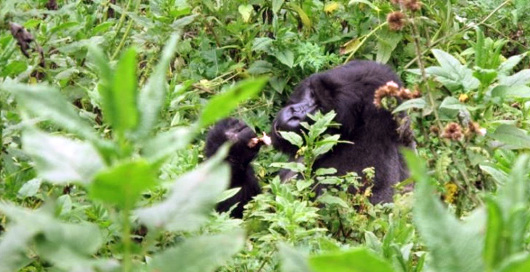 Silverback Rano
Silverback Rano
Fundi and I left the guards and other tracker at that point – we always approach the group with very few people in order to disturb the gorillas as little as possible. As we moved down the slope I learned to trust that the thick, matted vegetation would catch my feet so I won’t slide all the way down into the ravine with each step. We arrived at the spot where Titus and Ihumure, along with Segasira (another 3 year old) and Pato (a sub-adult male) were resting. Everyone looked peaceful except Ihumure. He had his eyes squeezed shut and was sleeping very, very soundly. The others were dozing, or grooming, or just resting while looking about. They were uninterested in our presence. The tracker told me in broken English that Ihumure looked very slow and weak this morning and that he was not eating much at all. That was the most alarming part of the report – these gorillas rely on plants for their water intake, and this little guy would get dehydrated quickly if he didn’t start eating soon. We watched them for about 45 minutes. At one point Titus looked me in the eye, and it took my breath away. His clear, brown, kind eyes were looking into mine. I was meeting a living legend and I felt very privileged. Ihumure began to move around and slowly pulled himself up and tried to groom Titus, but his hand just fell. His eyes had that unfocused look that we all get when we are in pain. He looked so pitiful – it broke my heart. I needed to get back to talk with Magdalena and Veronica so I looked up the slope, and this time I groaned out loud – Fundi laughed and said it was okay to go slowly. Thank goodness – I couldn’t have gone any other speed…I’ll be very happy once my body acclimates to this altitude.
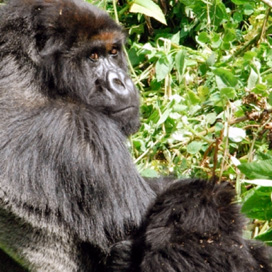 Titus and Ihumure
Titus and Ihumure
I spoke to Magdalena and Veronica when I got back into cell phone range. We discussed our options, weighing the costs versus benefits of anesthetizing Ihumure for diagnostic and treatment procedures. The group had recently had several interactions with some lone silverback gorillas – they were very tired and tense. In fact, Titus had received a wound on his right wrist last week that we had monitored for 2 days before it appeared to be healing well. Also, Titus is sticking very close to Ihumure. Considering all this, we determined that trying to anesthetize Ihumure could be dangerous for the group. It was possible that Ihumure had been injured in an interaction, and would improve with a little rest. So we decided visit the group daily to monitor the situation.
Magdalena visited the group on Sunday, and found that Ihumure was ever so slightly better. She saw him eat 2 pieces of wild celery, and he groomed Titus almost normally. The group has not moved much, so he had been able to rest. This was good news.
I went back up to evaluate Ihumure on Monday (I have to admit I was a little embarrassed at how slow I was probably going to have to go). I paced myself pretty well, and was absolutely amazed at how much better I did this trip than on Saturday. Part of it was that I knew what I was in for and I went very slowly, but part of it is that my body is actually adjusting. I marveled at physiology as I trudged up the trail.
When we got to the ravine, Ihumure was again sleeping with Titus, but when he woke up his eyes were clearer, and his movements more controlled. The trackers told me he had eaten that morning with much more strength than previously. I was so pleased. I knew he was not out of the woods by any means, but he was moving in the right direction at that point, so I was relieved. On the other hand, Titus still seemed pretty tired. He was resting more than expected, but we were all hoping he was just resting up from the last 2 weeks of interactions with lone silverbacks.
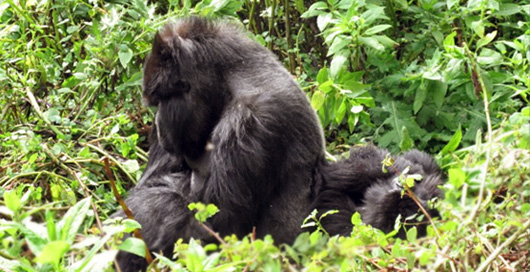
Ihumure sleeping next to Titus
Unfortunately we had been lulled into a false sense of encouragement. Ihumure improved daily, but 2 days later we received the startling news that Titus appeared to be near death. He did not leave his night nest and was only slightly alert. He had appeared to be resting so comfortably with little Ihumure. What had we missed? I wracked my brain. We again had many discussions between Magdalena, Jean-Felix, Veronica and I. I learned that this seems to be how silverbacks fade away – very similar to Shinda’s death. We determined that there was little we could do for Titus. We prepared for the necropsy. The mood was heavy at MGVP headquarters.
The next day Titus looked better, according to trackers. He was alert and eating. The group was rallying around him, and even better news was that Ihumure was MUCH better – even playing a bit with his brother. We allowed ourselves to be cautiously optimistic…
Two days later Titus died. Normally we want to get the body as soon as possible for a thorough necropsy, to learn as much as we can about the cause of death, but in this case the group was extremely disrupted. Ihumure stayed with Titus’s body for several hours, and would not eat. Magdalena spent the day with the group doing observations – we were all very, very worried about Ihumure. Titus had been his only ally. Tuck, the old female who has been with Titus for years, along with her 3.5 year old son, were not found for several hours that morning, but came back to visit the body that afternoon. Rano, Titus’s son and now group leader, was with the 2 blackbacks and one juvenile male of the group, and he seemed to be trying to move the group away from Titus, but they all kept circling back to Titus’s body. Ihumure finally moved away from Titus’s body, but he appeared to be afraid of the male group, so he sat by himself. Tuck didn’t appear to be comfortable with Rano either, so she and her son stayed separate from the male group, but would not sit with Ihumure. It was such a difficult time for these gorillas, and for the people who care for them. We gave the group 2 days to grieve, watching Ihumure carefully. He was weak, not eating well, but finally joined the male group. Titus’s body was carefully wrapped in plastic and blankets, and carried down the volcano for a necropsy. There are no words to truly express the feelings of loss that were palpable in this gorilla conservation community for the past several days.
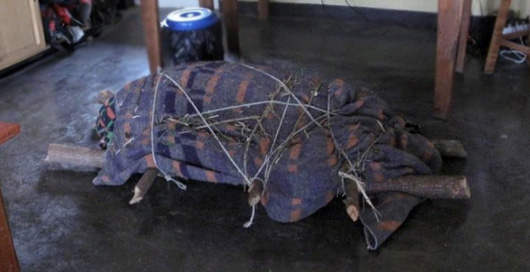 Titus’ body at MGVP headquarters, he looks so small
Titus’ body at MGVP headquarters, he looks so small
The day of Titus’s necropsy was a very long day. We found that the wound on his wrist was deeper than anyone thought. But he was using the hand to walk, and to eat so there was no way for us to know. Other than that, he was thin, but no obvious cause of death. Unfortunately, it is not uncommon to find little in cases like this. Tissues were placed in formalin and frozen, and will be brought back to our pathologist in the US for closer inspection. Titus was buried near Dian Fossey up at the original Karisoke Research Station site. It is beautiful there.
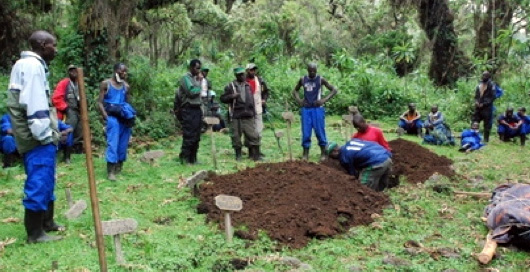 Titus’ burial at Dian Fossey’s grave
Titus’ burial at Dian Fossey’s grave
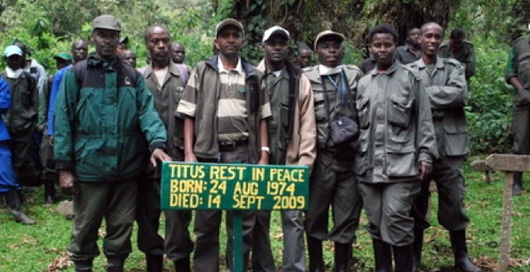 Titus’ grave
Titus’ grave
We didn’t have much time to grieve. Ihumure continued to decline. The situation was very difficult from a medical and ethical perspective. If we attempted to do a full intervention (anesthesia, sampling, fluid therapy, etc.) the group might leave the area – they were very unstable. If the group left during an anesthetic procedure, we might not be able to successfully get Ihumure back into the group once he recovered from anesthesia. If we chose not to do a full anesthesia, we may never know the cause of his weakness, and we still may lose him. After long discussions between all the gorilla doctors and Veronica from Karisoke, we decided to try the least invasive “shot gun” method of giving him a chance. He was darted with antibiotic, antiparasitic and anti-inflammatory drugs.
Ihumure died the night after his father was buried. His little body was brought to MGVP headquarters for a necropsy, and this time we found the cause of death. He had severe trauma to the kidney and an intussusception of the bowel (one piece telescoped into another). We could not have saved him. It is good to get a diagnosis, and to know there was little we do, but so difficult to realize how much he suffered. We veterinarians deal with life and death regularly, but this has been an emotional time.
We buried him according to the protocol of a physical anthropologist who is studying the bones of Mountain Gorillas. He was laid in this little box in a very specific way so that the bones will be in anatomically correct position when they are retrieved in about a year. The box was filled with loose dirt, and he was buried at a specific depth to maximize natural cleaning of the bones. His grave was marked with rocks in the little graveyard at park headquarters and with GPS coordinates. This all seems very matter of fact. But really, it seems fitting, and a way to honor Ihumure and his species. To learn as much as we can from his little body. To help us better understand Mountain Gorillas so that we can best protect them and their environment.
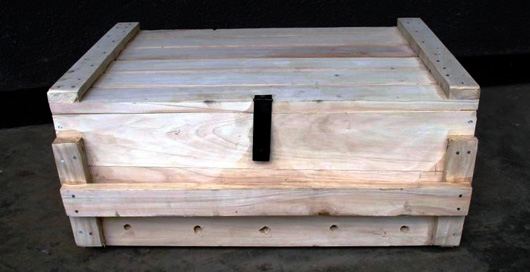
Immediately after we finished with this necropsy I took a family who is doing a story on MGVP to see the gorilla orphans in Kinigi. It was nice to see this group of healthy, content orphans, each of whom has a tragic story, displaying for our benefit, and for the sheer joy of displaying! Lifted my spirits. More about them soon.
Help the Gorilla Doctors.


 Donate
Donate